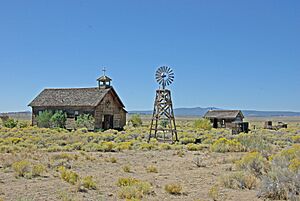Fort Rock Valley Historical Homestead Museum facts for kids

Belletable House in front of Fort Rock
|
|
| Established | 1988 |
|---|---|
| Location | Fort Rock, Oregon, U.S.A. |
| Type | Oregon history |
The Fort Rock Valley Historical Homestead Museum is a special place in Fort Rock, Oregon, United States. It opened in 1988. This museum is like a small village made of old buildings from the early 1900s. These buildings were once homes, a church, and a school. They were moved here from different spots in the Fort Rock Valley. This valley is named after the cool volcanic rock formation called Fort Rock.
Inside these old buildings, you can see many items used by the people who lived there long ago. There's old furniture, dishes, and tools. The museum lets you explore on your own. It's open from late May through early September.
Contents
Discovering the Fort Rock Valley Museum
A Look Back: History of the Valley
The Fort Rock Valley is a large area, about 200 square miles (520 km2) big. It sits high up, around 4,400 feet (1,300 m) above sea level. From 1905 to about 1915, many people moved to this valley. They came to claim land from the government to start farms and ranches. This was part of the Homestead Acts.
Many small towns popped up in the valley. Some of these towns were Fremont, Lake, Sink, and Fleetwood. But the high desert here has very hot, dry summers. Winters are extremely cold. The valley gets less than 9 inches (230 mm) of rain each year. Also, the growing season is very short. Because of this tough weather, most people had to leave their land after just a few years. Most of the towns' post offices closed by 1920. Today, only Fort Rock and Silver Lake remain from that time.
The idea for the Fort Rock Valley Historical Homestead Museum came from Frank and Vivian Stratton. They both grew up on homesteads in the Fort Rock area. In 1981, they joined others who loved local history. They formed the Fort Rock Valley Historical Society. This group wanted to create a museum. Their goal was to save the history of the pioneers in the Fort Rock Valley.
Thanks to their hard work, the museum opened in 1988. It started with two historic buildings. Since then, the museum has grown a lot. It has gained more land and more buildings. Many of these buildings were old and unsafe. They were going to be torn down or burned. The museum saved them from being destroyed.
Amazing Old Buildings and Items
The people who work and volunteer at the Fort Rock Valley Historical Homestead Museum do a great job. They help keep the old buildings and items safe. They also show what life was like long ago. You can see a real community garden. There's also a visitor center and gift shop.
The museum has eleven historic buildings that were saved. Most of them came from the Fort Rock Valley. Inside, you'll find many items from homesteaders. These include furniture, dishes, and tools. The exhibits change with the seasons. They show how people lived during that time.
- The Webster Cabin was one of the first two buildings at the museum in 1988. Britt Webster built it. It was used as a home until 1986.
- The Sunset School is the only pioneer schoolhouse left in the valley. There used to be twenty of them! It was moved to Fort Rock to be a church. Later, it was given to the museum in 1998.
- The Fred Stratton Home was where Frank Stratton grew up. He was one of the museum's founders. This house was moved from a ranch.
- St. Roses Catholic Church was the only church built in the valley during the homestead years. It was moved to the museum from its original spot.
- The Belletable House is thought to be the biggest pioneer home in the valley. It was once the museum's visitor center.
- The Bodenheimer House was one of the few two-story houses. A German carpenter built it.
- The Menkenmair Cabin is the only log cabin left in the valley.
- Dr. Thom's office was another original museum building. Dr. James W. Thom was the only doctor in the valley back then. His office was in Silver Lake.
- The Land Office is a log building that looks like ones from the homestead period. It wasn't originally from the Fort Rock Valley. The museum saved it from a building site near Bend, Oregon.
- The Fort Rock General Store used to be just two blocks from the museum. It survived a big fire in the 1960s. It was later used as a home and a repair shop. In 2009, it was given to the museum. After a lot of cleaning, it now looks like the original store. It's filled with old goods and equipment from the homestead era. The metal sign on the building is the real one!
Visiting the Museum
The Fort Rock Valley Historical Homestead Museum is located right at the main road in Fort Rock. The museum is open on Friday, Saturday, and Sunday. This is from mid-May through the end of September. You can take self-guided walking tours from 10:00 a.m. to 4:00 p.m. If you have a group, you need to arrange your visit ahead of time. The visitor center has exhibits, books, gifts, and public restrooms.







